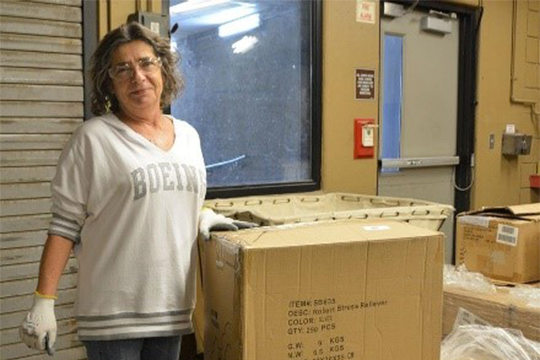At Boeing, we are creating a workplace where every person who works on our property goes home as safe and healthy as when they arrived. We believe all injuries are preventable.
To meet this goal, we began implementing a variety of safety standards, including the use of personal protective equipment (PPE), across the enterprise in 2014. These standards apply to all employees, contractors, suppliers, customers, and visitors. To build a strong safety culture, we maintain a clear and consistent emphasis on safety, first-time quality, and integrity.
With 150,000 employees across the United States and in more than 65 countries, safety standards are critical to creating a common understanding of what safe behavior looks like in our work environments. Our standards relate to office and industrial settings, such as manufacturing, operations, production, and warehouses, although the safety requirements vary between sites due to the specific type of work being done.
Boeing’s Go for Zero Safety Standards:
- 35-Pound Lifting
- A-Frame Ladder
- Bump Caps
- Electronic Devices
- Factory Automation Safety
- Foot Protection
- Forklift Use
- Hand Cut Protection
- Hearing Protection
- High Visibility Wear
- Industrial Athlete
- RSI Guard Ergonomic Software
- Safety Glasses
- Service Provider Safety
- Visitor Safety
To date, we have introduced 15 documented and approved PPE standards and have achieved notable reductions in recordable injuries:
• Bump caps — 49 percent fewer head injuries
• Safety glasses and enhanced eye protection (e.g., safety goggles, face shields) — 27 percent fewer eye injuries
• A-frame ladder reduction standard — 29 percent fewer injuries.
• In both office and industrial settings, our lifting standard has reduced injuries by 31 percent.
• Use of the computer ergonomic software tool, RSIGuard, is a safety standard and it has reduced repetitive strain injuries (RSI) by 44 percent since inception. RSIGuard is installed automatically on all Boeing workstations.
In the past year, Boeing has introduced three new standards: hand cut, hearing and foot protection. In addition to improved statistics, we’re seeing improved employee morale and wellness, and improvements in the quality of production.
One of many success stories
Faith Ivey, St. Louis, spent many years moving, lifting, packing, unpacking and sorting nearly every kind of package coming through the mailroom. Then, Enterprise EHS introduced a lifting safety standard that limits the weight an individual employee can lift alone to 35 pounds.
“It’s one of the best things that Boeing has done for its people,” Ivey said. Her conviction was put to the test when a large pallet arrived on the loading dock. Each box on the pallet weighed more than the single person lift limit, so Ivey spoke up. Because of the support she was getting from her management, she told the supplier about the 35-pound lift. Ivey said. “I asked them to repackage the shipment; they responded right away and fixed the situation.”
Making PPE standards stick
Implementation of a safety standard starts with an EHS risk assessment to determine what protective equipment is required in a specific situation or environment (e.g., bump caps are mandatory in the shadow of an airplane).
Once the requirements are complete, a set of resources reinforce safety standard implementation at the local level:
- Correct PPE equipment is easily accessible at the job site, to every employee.
- PPE standards are discussed regularly at crew meetings and spot checks.
- A Qualified Products List is provided to identify the correct equipment to use.
- EHS staff are trained and prepared to answer questions and assist in acquiring the correct gear.
- A variety of documentation and communication methods emphasize the company’s safety standards (e.g., The Enterprise-Wide Environment, Health & Safety Standards Manual, posters, websites).
Challenges with implementation
Although we’re seeing successes from these standards, compliance and consistency can be a challenge.
Another challenge is adapting to new technologies and potential distraction factors. Our electronic device standard restricts the use of devices when walking in operations and transportation areas, everywhere on property owned or operated by Boeing (including parking lots, flight lines, factories and warehouses) except in Safety Zones. We are focused on improving safety with the use of tablets, Google Glasses, cell phones and other electronic equipment.
We remain committed to improving compliance and consistent standards application – at all levels of the company – to ensure injury prevention and first-time quality.
Our safety journey continues
Our introduction of safety standards is helping to create a stronger safety culture at Boeing. The standards are a common sense, practical method to keep our teammates safe across the enterprise. Our safety journey isn’t complete, and we are far from declaring victory. Safety, quality and integrity are our responsibilities, and we own them.
Paul Wright – Director, Enterprise Workplace Safety, The Boeing Company
Boeing is a Campbell Institute member. Learn more about our participants.


Add Comment